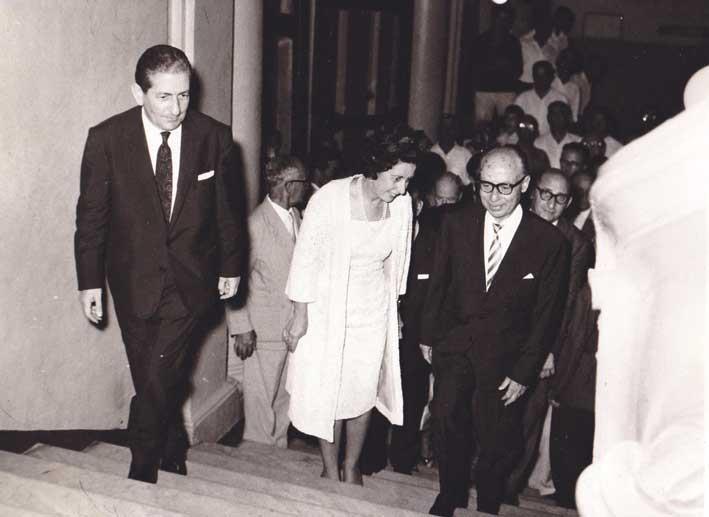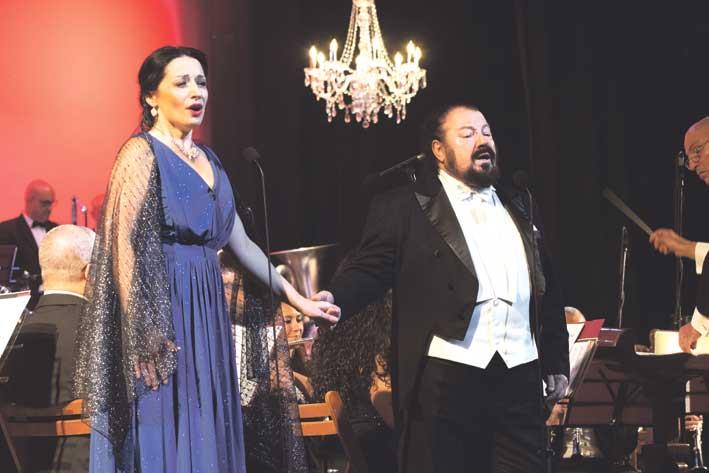The Saturday before last the stage of The Catholic Institute was ablaze with four crystal chandeliers and a huge reproduction of one of the two famous portraits of Giuseppe Verdi painted between 1885 and 1886 by Giovanni Boldini. Boldini had his studio in Place Pigalle and the portraits were painted during Verdi's Paris years. I am sure some of you will remember one of these portraits of Verdi on the 1000 lire notes. The original is now at Gallaria d'Arte Moderna in Rome. The other in the home he built for retired musicians in Milan.
On the stage too there was the Standard of the band and also a papier maché reproduction of Grand Master La Valette, with his famous sword, posing as if he was about to join the band. All very colourful and festive. I loved it. La Valette would have too.
The souvenir programme, with Verdi's twinkling eyes on the cover, is truly worth keeping with its many photographs and history of the band.

Maestro Botti with former PM Dr Borg Olivier and Mrs Borg Olivier
It is not very common to have a band as opposed to an orchestra accompanying opera singers but although I missed the violins, especially, it hardly detracted from the evening's pleasure.
The singers were the Bulgarian tenor, Kaludi Kaludov and soprano Anna Dytry who was at one time his pupil. The Coro Bel Canto was a worthy addition to the evening which was presented by popular actor Mario Micallef.
The fact that it was a Verdi evening already put the audience, including myself, in a good mood. Here we were being entertained by two excellent singers and choir and an experienced band and maestro who had all worked hard behind the scenes.

Maestro Domenic Darmanin baton in hand
This concert Omaggio A Giuseppe Verdi was to celebrate the 145th anniversary from the foundation of the Società Filharmonica Nazionale La Valette and 92 years since the band won an important First Prize at the Como Festival, a reward of which the band is so rightly proud.
Led by Maestro Dominic Darmanin who made a fine and elegant figure in tails, the orchestra, the males smartly wearing a bow-tie and choir rose to the occasion. No sloppiness allowed here. I shouldn't think the maestro would allow it.
In 19th century Italy Verdi stood head and shoulders above all others. His operas are full of great tunes, among them Brindisi and Parigi O Cara, from La Traviata, La Donna è mobile from Rigoletto to mention but a handful. In total he wrote 26 operas most of which are still being performed today. They include many of the best operatic arias of all time.
Verdi was a big hit with opera audiences across Italy, and when AÏda received its premiere, the standing ovation at the end was so prolonged that the company made no fewer than 32 curtain calls.
That evening, to my delight, all three arias we sung by the guest singers.

The Polish soprano Anna Dytry and Bulgarian tenor Kaludi Kaludov singing a duet
The Coro Bel Canto accompanied by the musicians gave us the evergreen and ever popular Chorus of the Hebrew Slaves or Va Pensiero from Nabucco. This is the opera that brought Verdi back from the brink. He had been ready to give up composing for good. It was by no means solely the critical failure of his previous opera, Un giorno di regno, that was responsible either. After all Verdi had endured the worst of times not long before with the death of his first wife and children.
The public hammering over Un giorno di regno saw Verdi inside his agent's office, telling him his musical career was over. Suddenly envisaging the death of Italian opera or his 10 per cent commission or both, his agent proffered a copy of a libretto by a writer named Temistocle Solera, inspired by Psalm 137.
By the rivers of Babylon we sat and wept when we remembered Zion.
There on the poplars we hung our harps, etc.
Verdi read the libretto on his journey home and by the time he had arrived, the words Va pensiero had captured his imagination.
This powerful chorus from the third act of the opera Nabucco (1842) recollects the story of Jewish exiles in Babylon after the loss of the First Temple in Jerusalem. The opera was a smash and established Verdi as a major composer in the 19th century Italy. In fact Va pensiero became a popular anthem for Italian patriots, who were seeking to unify their country and free it from foreign control. Perhaps this is what should have become Italy's national anthem for it is all about struggle, too.
Thank you Coro Bel Canto for singing it so beautifully.
La Traviata based on Dumas' La Dame aux Camélias premiered in 1853 with a disastrous first night. But as we know it's been a roaring success ever since.
This much loved opera was present that evening with the Preludio, Parigi o cara and the Brindisi. In Parigi o cara, the tenor and soprano's voices blended perfectly. It was a touching performance.
It's fair to say that Verdi was playing hard to get when it came to Aïda. He was being pursued seemingly constantly by Ismail Pasha, the Khedive of Egypt and Sudan, to write for various state events, the opening of the Suez Canal being one of them. When the Cairo Opera House was being unveiled in 1869, Verdi finally agreed to compose something. Even then he asked for a phenomenal free, almost as if trying to price himself out of the market. Fee agreed he set about working on an opera with a specially commissioned Egyptian archaeology theme. Sadly, the Franco-Prussian war meant that costumes and set got stuck in Paris and Cairo opened with Verdi's Rigoletto. Aïda made it to Cairo only in 1871 nearly two years late.
We enjoyed three pieces from Aïda that evening. It is not my favourite opera. I watched it twice over and have vowed never to torture myself again. However, he selected pieces are in fact the ones I like.
Rigoletto, based on Victor Hugo's Le roi s'amuse though composed some 18 years earlier had maintained its popularity. The Duke of Mantua's aria La Donna e Mobile was being sung in the streets the next day. And it was also sung with vigour, by Kaludi Kaludov that celebratory evening. He is a poised and controlled singer though next time round I would like to see him without a horsetail.
There is more to be said about this concert but there is no space to do it in.
I would like to mention Maestro Cardenio Botti. He is the great uncle or perhaps uncle, of the pianists Maryann and Nadya Kissaun, who too have music in their genes.
He came to Malta in April 1923 with one mission, to improve musical education here. He was in Malta for over 22 years and contributed immensely to the local music scene but especially to the Società Filarmonica Nazionale La Valette who remained in contact with him even after he left. From Malta he went back to Italy, against his wishes but Mussolini had taken over, and was appointed musical director of the Teatro Fenice in Genova.
That evening one of his compositions, Siam de la Valette was played with gusto.
Maestro Darmanin, the musicians, choir and singers got two standing ovations.
This was a huge collaborative effort made possible by many people but one of the persons behind it was Tonio Portughese whose main hat is that of chairman of PBS but who is also consultant on the editorial board of the Società. Having himself organised so many opera and operetta concerts at the Manoel his experience must have come in handy.
All I can say is Congratulations all concerned for a most worthwhile evening.
[email protected]